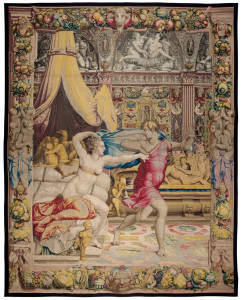
Di Maria Maddalena Grossi (Università degli Studi di Firenze, Dipartimento S.A.G.AS.)
Firenze e Palazzo Vecchio rendono omaggio ai visitatori di Expo 2015 (e non solo) con una mostra del tutto eccezionale che vede riunire dopo centocinquanta anni i magnifici arazzi commissionati da Cosimo I de Medici tra il 1545 e il 1553 per la Sala dei Duecento in Palazzo Vecchio.
I venti arazzi di grandezze monumentali (si parla di sei metri di altezza ciascuno per una estensione di più di quattrocento metri quadrati!) furono realizzati dai maestri fiamminghi Jan Rost e Nicolas Karcher sui cartoni dei fiorentini Jacopo da Pontorno e Francesco Salviati.
La straordinarietà di questi arazzi è dovuta non solo agli artisti fiamminghi e fiorentini che vi operarono in maniera congiunta, ma anche all’occasione stessa che si creò per la prima volta a Firenze con tale committenza; grazie a Cosimo I de Medici si creò infatti una vera e propria manifattura che rimarrà attiva a Firenze per due secoli.
Il visitatore è introdotto alla mostra da un video che in chiave storica riproduce la nascita degli arazzi, i protagonisti sono degli attori che nelle vesti di Cosimo I dei Medici e di Eleonora di Toledo immergono per circa quindici minuti il visitatore nella Firenze medicea. Compaiono inoltre il curatore della mostra …. , ilsindaco Dario Nardella e la ex Soprintendente Cristina Acidini che illustrano le vicissitudini di queste opere e l’importanza che hanno nella storia dell’arazzo, nonché il meticoloso restauro che hanno subito gli arazzi ad opera dell’ Opicifio delle Pietre dure di Firenze e dall’ Icr di Roma grazie anche al contributo dell’Ente Cassa di Risparmio di Firenze.
Gli arazzi narrano la storia di Giuseppe, figlio prediletto di Giacobbe, che detestato dai fratelli viene venduto come schiavo in Egitto, ma Giuseppe riesce a trionfare su tutte le insidie presenti sulla sua strada e a farsi valere difronte ai potenti. Ricoprirà un ruolo di primo piano a fianco del faraone, ma la sua vera grandezza sarà il perdonare i fratelli che lo avevano odiato e tradito.
L’idea dell’eroe mite, che solo con l’intelligenza e le proprie forze, dal nulla riesce a creare un impero e a sfuggire alle insidie, colpì Cosimo I dei Medici che rivide le vicissitudini della propria famiglia. Con queste intenzioni nasce la committenza agli artisti fiamminghi e fiorentini, pertanto l’opportunità di questa mostra, di rivedere riuniti insieme gli arazzi è unica e irripetibile.
Inoltre la mostra ripropone l’allestimento come lo si presentava al tempo di quando Cosimo I dei Medici li vide realizzati, ovvero con le pareti del Salone dei Duecento interamente ricoperte dagli arazzi. I supporti didascalici posti in basso alle opere e numerati secondo l’ordine delle storie permettono di capire e scorrere in modo autonomo le opere.
Translation by Bethany Hucks (Istituto Lorenzo de’ Medici)
Florence and the Palazzo Vecchio give homage to the visitors from Expo 2015 (and others) with an exhibition of exceptional works that sees the reunion, after 500 years, of the magnificent tapestries commissioned by Cosimo I de’ Medici between 1545-1553 for the Room of the 200 in Palazzo Vecchio. The twenty tapestries of enormous size (each is six meters high, together stretching more than 400 meters square!) were created by Flemish masters Jan Rost and Nicholas Karcher from drawings done by Florentines Jacob da Pontorno and Francis Salviati.
The extraordinary nature of these tapestries comes not only from the Flemish and Florentine artists that worked together, but also from the opportunity that was created for the first time in Florence with this commission; thanks to Cosimo I de’ Medici, this resulted in workshops that remained active in Florence for 200 years.
The visitor is introduced to the exhibition by a video in which the key histories reproduce the creation of the tapestries. The lead characters are actors who, dressed as Cosimo I de’ Medici and Eleanora di Toledo, immerse the visitor in Medicean Florence for around 15 minutes. Also appearing in the film are exhibition curator Louis Godart, mayor Dario Nardella, and former Superintendent Cristina Acidini, who illustrate the turbulent history of these works and their historical importance in the history of tapestries, as well as the meticulous restoration that the tapestries underwent at the Factory of Semiprecious Stones in Florence and the ICR in Rome, thanks to the contribution of the Ente Savings House of Florence.
The exposition replicates the set-up as it would have been seen in the time of Cosimo I dei Medici, with the walls of the Room of the 200 completely covered by the tapestries. The descriptive labels are placed below the works and are numbered according to the order of the story, allowing visitors to understand and follow the works on their own.
The tapestries tell the story of Joseph, favorite son of Jacob who, loathed by his brothers, was sold as a slave in Egypt. But Joseph succeeds in triumphing over all of the pitfalls in his path and asserting himself in the face of this powerful opposition. He becomes the pharaoh’s right-hand man, but his true greatness would be forgiving the brothers who hated and betrayed him.
The idea of the mythological hero who, with just his intelligence and his own strength, rose from nothing to create an empire and overcome obstacles, struck Cosimo I dei Medici, who saw in the story the vicissitudes of his own family. Out of these ideas was born the commission for the Flemish and Florentine artists, and therefore the opportunity for this exhibition, to see once again these unique and unforgettable tapestries.